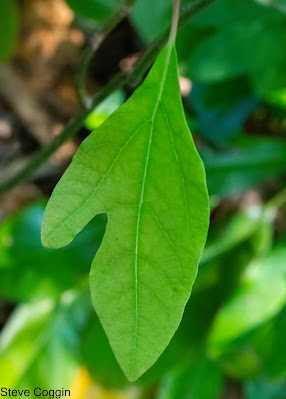 |
| Wild Coffee (Psychotria nervosa), a native of Florida, has simple leaves. Palm Beach County, Florida. |
As leaves emerged this spring, I was fascinated by the variety of their shapes. Leaves are large and small, wide and narrow, simple and compound, and more. With spring light streaming through them, these leaves glow with a profusion of greens and dazzle with their forms.
Botanists have a welter of terms to describe the shape of
leaves. The flat part of the leaf is the
blade. It usually has a large surface area for carrying out photosynthesis. The blade is connected to the stem by the
petiole. At the point where the petiole
emerges, there is a bud that has the potential to grow into a new
branch.
 |
| The simple leaf of American Basswood (Tilia americana) showing the blade and petiole. Rowan County, North Carolina. |
Simple leaves are, of course, the simplest, with a blade and a petiole. But even simple leaves show astonishing variation. For example, simple leaves may have smooth margins, or they can be edged with teeth.
 |
| American Beech (Fagus grandifolia) trees have simple leaves with toothed margins. Rowan County, North Carolina. |
Some simple leaves have lobes. Many species of Maple (Acer sp.), American Sycamore (Platanus occidentalis), Sweetgum (Liquidambar styraciflua) and a variety of Oaks (Quercus sp.) have lobed leaves.
 |
| The lobed leaves of Red Maple (Acer rubra). Rowan County, North Carolina. |
 |
| Silver Maple (Acer saccharinum) with lobed leaves. Rowan County, North Carolina. |
 |
| Lobed leaves of American Sycamore (Platanus occidentalis). Rowan County, North Carolina. |
 |
| White Oak (Quercus alba) leaves have large rounded lobes. Rowan County, North Carolina. |
 |
| Swamp Chestnut Oak (Quercus michauxii) leaves have small rounded lobes. Rowan County, North Carolina. |
 |
| Northern Red Oak (Quercus rubra) has pointed lobes. Rowan County, North Carolina. |
Red Mulberry (Morus rubra) can have both lobed and unlobed leaves, even on the same tree. Sassafras (Sassafras albidium) leaves can have no lobes, two lobes or three lobes.
 |
| An unlobed Red Mulberry (Morus rubra) leaf. Rowan County, North Carolina. |
 |
| A lobed Red Mulberry leaf. Rowan County, North Carolina. |
 |
| An unlobed Sassafras (Sassafras albidum) leaf. Rowan County, North Carolina. |
 |
| A two-lobed Sassafras leaf. Rowan County, North Carolina. |
 |
| A three-lobed Sassafras leaf. All these Sassafras leaves were on the same tree. Rowan County, North Carolina. |
Tulip Poplar (Liriodendron tulipifera) leaves have a unique lobed pattern with two lobes at the broad tip and two to four lobes near the petiole.
 |
| The distinctive lobed leaves of Tulip Poplar (Liriodendron tulipifera). Rowan County, North Carolina. |
Some leaves, like those of Yarrow (Achillea millefolium), have very deep lobes. These leaves are called dissected.
 |
| A dissected leaf of Yarrow (Achillea millefolium). Rowan County, North Carolina. |
Compound leaves have a petiole with multiple leaflets. They come in two forms, palmately compound and pinnately compound. Palmately compound leaves, like Saw Palmetto (Serenoa repens) and Virginia Creeper (Parthenocissus quinquefolia), have the leaflets emerging from a single point at the end of the petiole. This leaf type resembles fingers emerging from the palm of a hand. The palmate arrangement gave palm trees their name.
 |
| Saw Palmetto (Serenoa repens) has palmately compound leaves. Palm Beach County, Florida. |
 |
| A palmately compound leaf of Virginia Creeper (Parthenocissus quinquefolia). Rowan County, North Carolina. |
Pinnately compound leaves have leaflets emerging along the length of the central vein. American Ash (Fraxinus americana), Pignut Hickory (Carya glabra) and Smooth Sumac (Rhus glabra) all have pinnately compound leaves. One species of maple found in the Southeast, Boxelder (Acer negundo), has pinnately compound leaves rather than lobed leaves.
 |
| Pinnately compound leaves of American Ash (Fraxinus americana). Rowan County, North Carolina. |
 |
| A Pignut Hickory (Carya glabra) pinnately compound leaf seen from below. Rowan County, North Carolina. |
 |
| Smooth Sumac (Rhus glabra) has pinnately compound leaves. Rowan County, North Carolina. |
 |
| Unlike most maples, Boxelder (Acer negundo) has pinnately compound leaves. Rowan County, North Carolina. |
 |
| Linear leaves of Gray's Sedge (Carex grayii). Davidson County, North Carolina. |
 |
| Common Rush (Juncus effusus) has round, linear leaves. Rowan County, North Carolina. |
Some plants have heart-shaped leaves. The technical term for this leaf type is cordate. Eastern Redbud (Cercis canadensis) and
Air Potato (Dioscorea bulbifera) both have cordate leaves.
 |
| Redbud (Cercis canadensis) has heart-shaped or cordate leaves. Rowan County, North Carolina. |
 |
| Dioscorea bulbifera or Air Potato has cordate leaves. This native of Africa and Asia is an invasive species in the Southeastern United States. Palm Beach County, Florida. |
A peltate leaf resembles an umbrella, with the petiole attached to the center of the blade. Mayapple (Podophyllum peltatum) has peltate leaves that are palmately lobed. The specific name for Mayapple refers to the leaf shape.
 |
| A peltate leaf of Mayapple (Podophyllum peltatum) from above. Rowan County, North Carolina. |
 |
| A peltate leaf of Mayapple from below. Rowan County, North Carolina. |
A perfoliate leaf lacks a petiole and the base of the blade surrounds the stem. This pattern is seen in the early spring wildflower, Perfoliate Bellwort (Uvularia perfoliata). As with Mayapple, the specific name refers to the leaf type.
 |
| A perfoliate leaf of Perfoliate Bellwort (Uvularia perfoliata). Rowan County, North Carolina. |
Besides being part of a dazzling botanical show, the shape of
leaves is useful and even essential for plant identification. Generations of plant taxonomy students and others haven been intimidated by and mastered the terms that describe leaves. This is part of a journey to learn the plants around us.












